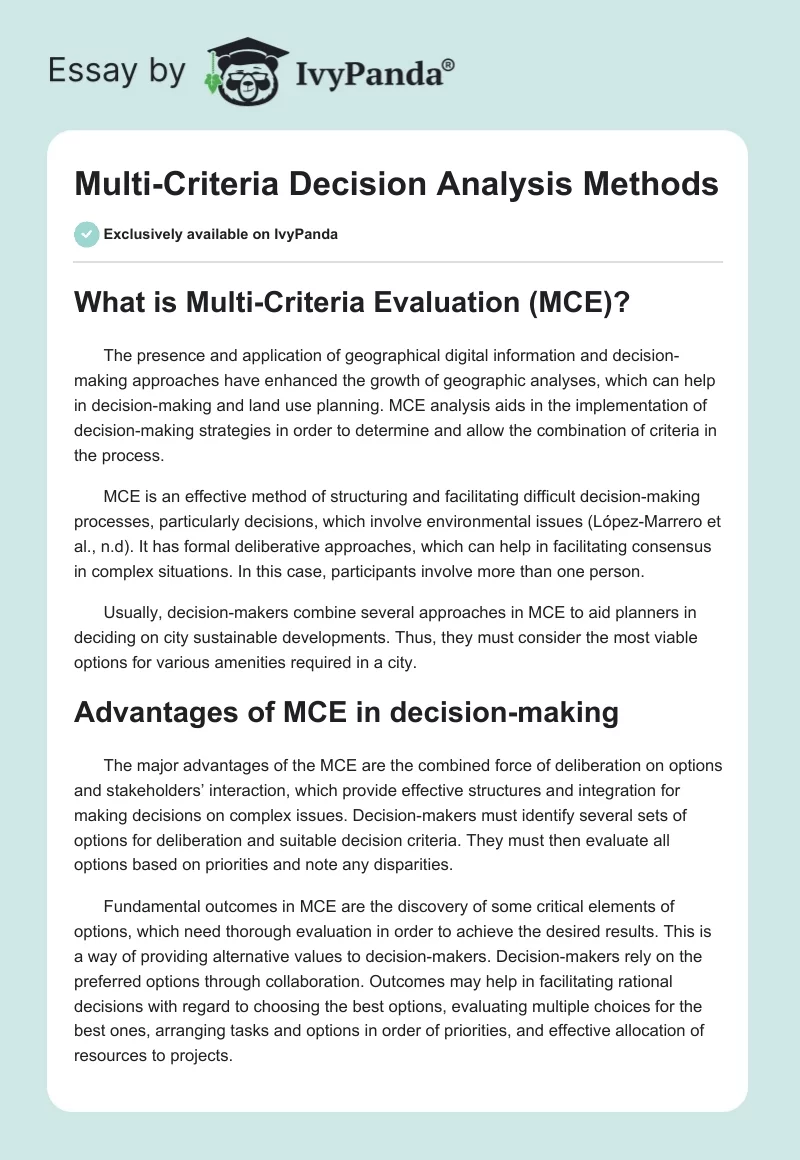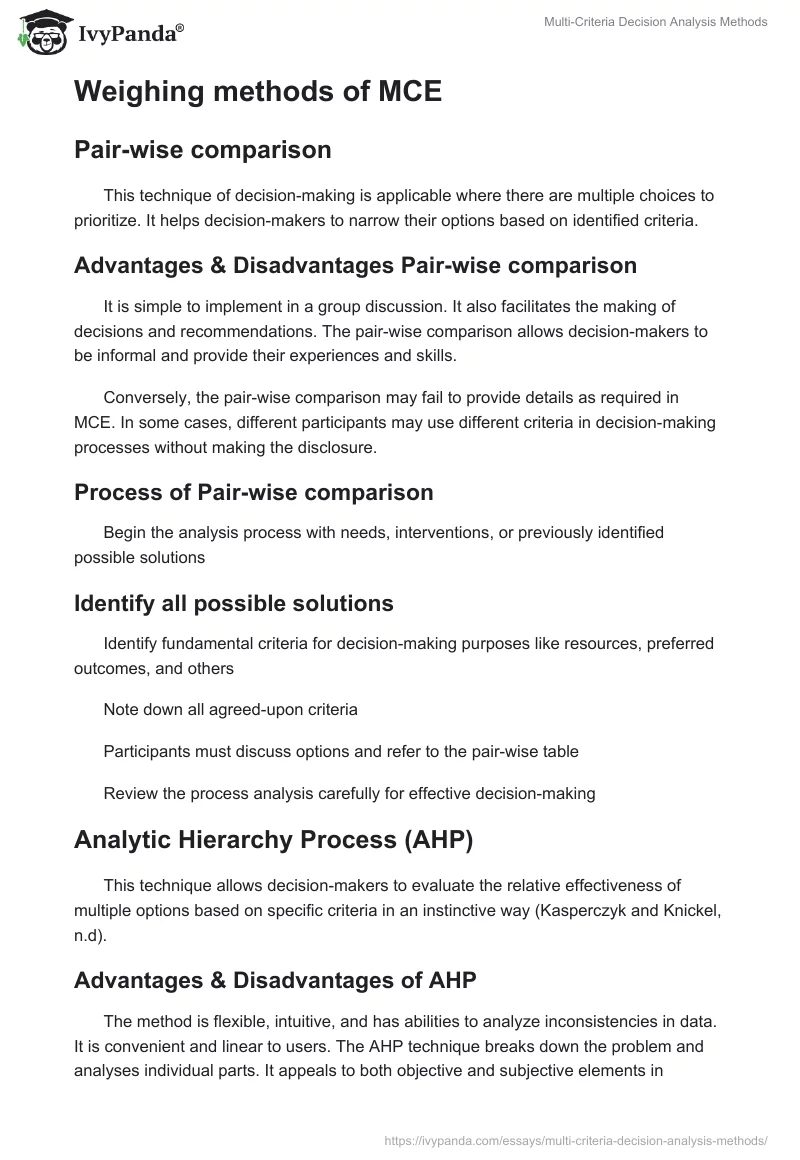What is Multi-Criteria Evaluation (MCE)?
The presence and application of geographical digital information and decision-making approaches have enhanced the growth of geographic analyses, which can help in decision-making and land use planning. MCE analysis aids in the implementation of decision-making strategies in order to determine and allow the combination of criteria in the process.
MCE is an effective method of structuring and facilitating difficult decision-making processes, particularly decisions, which involve environmental issues (López-Marrero et al., n.d). It has formal deliberative approaches, which can help in facilitating consensus in complex situations. In this case, participants involve more than one person.
Usually, decision-makers combine several approaches in MCE to aid planners in deciding on city sustainable developments. Thus, they must consider the most viable options for various amenities required in a city.
Advantages of MCE in decision-making
The major advantages of the MCE are the combined force of deliberation on options and stakeholders’ interaction, which provide effective structures and integration for making decisions on complex issues. Decision-makers must identify several sets of options for deliberation and suitable decision criteria. They must then evaluate all options based on priorities and note any disparities.
Fundamental outcomes in MCE are the discovery of some critical elements of options, which need thorough evaluation in order to achieve the desired results. This is a way of providing alternative values to decision-makers. Decision-makers rely on the preferred options through collaboration. Outcomes may help in facilitating rational decisions with regard to choosing the best options, evaluating multiple choices for the best ones, arranging tasks and options in order of priorities, and effective allocation of resources to projects.
Weighing methods of MCE
Pair-wise comparison
This technique of decision-making is applicable where there are multiple choices to prioritize. It helps decision-makers to narrow their options based on identified criteria.
Advantages & Disadvantages Pair-wise comparison
It is simple to implement in a group discussion. It also facilitates the making of decisions and recommendations. The pair-wise comparison allows decision-makers to be informal and provide their experiences and skills.
Conversely, the pair-wise comparison may fail to provide details as required in MCE. In some cases, different participants may use different criteria in decision-making processes without making the disclosure.
Process of Pair-wise comparison
Begin the analysis process with needs, interventions, or previously identified possible solutions
Identify all possible solutions
Identify fundamental criteria for decision-making purposes like resources, preferred outcomes, and others
Note down all agreed-upon criteria
Participants must discuss options and refer to the pair-wise table
Review the process analysis carefully for effective decision-making
Analytic Hierarchy Process (AHP)
This technique allows decision-makers to evaluate the relative effectiveness of multiple options based on specific criteria in an instinctive way (Kasperczyk and Knickel, n.d).
Advantages & Disadvantages of AHP
The method is flexible, intuitive, and has abilities to analyze inconsistencies in data. It is convenient and linear to users. The AHP technique breaks down the problem and analyses individual parts. It appeals to both objective and subjective elements in different options. Thus, it eliminates bias in the process of decision-making. The AHP relies on consensus based on the geometric mean of different options. It can provide a scale of measure in situations where they are not available.
AHP may lead to irregularities in ranking options. Aggregation between bad and good scores can cause data omission and loss. Breaking down all problem decisions can lead to large and complex data for analysis.
Process of AHP
Determine decision problems and criteria for choosing options
Weigh and prioritize options
Assess scoring of all options
Determine a common score for all options
Drop and compute options when necessary
Equal weights method
This method is effective when options are numerous.
Advantages & Disadvantages
The method reduces a large number of solutions for consideration. Determining the solution for a problem may be easier if decision-makers identify non-equal sets.
This method may lead to a set of solutions instead of a single one. Moreover, the final decisions rest with decision-makers. It does not assert that decision-makers will find all non-equal sets. Finally, determining the number of equal sets may not be easy because it depends on different arrangements of weights. Still, a large number of criteria may be difficult to weigh
Process
Determine and combine various criteria based on a range of weightings
Determine the best solution for every group
Review for the best weightings
SIMOS
This is an indirect technique, which relies on the hierarchical ranking of various criteria. The method is not arbitrary like one, which depends on the direct allocation of weights. Moreover, it is simple to understand. It also provides freedom for decision-makers to evaluate their preferences (Figueira and Roy, 2002).
Advantages & Disadvantages of SIMOS
The method is simple and has intuitive processes. However, it presents significant challenges in data compilation.
Process of SIMOS
Rank the preferred criteria based on the most and least preferred
Allocate a position to every criterion with the lowest criterion getting the first position
Determine non-normalized weight or average of every rank. This happens by determining the aggregate of the criteria in the rank and then diving by the total positions of the rank.
Determine the relative weight or normalized weight of all criteria. This involves dividing the “non-normalised weight of the rank by the total sum of the positions of the criteria” (Olson, 2001).
Delphi technique
This is a common method in information system studies. It enhances the confidence in data gathered for decision-making. It is critical in situations where judgemental data are highly regarded (Custer, Scarcella, Stewart, 1999).
RAND Corporation created the technique in the 1950s in order to provide opportunities for many experts to provide their opinions jointly on complex problems. Delphi technique was useful in predicting technologies of the future. The main approach of Delphi technique is “structuring a written, asynchronous communication process among a large problem-solving group so that it is tailored to the nature of the problem, the characteristics of the group, and the objectives of the problem-solving exercise” (Linstone and Turoff, 2002).
Delphi relies on problem-solving approaches, which relate to assessment, comprehension, and evaluation. Participants can join the process at any phase. Thus, it reduces constraints on contributors.
Advantages & Disadvantages of Delphi technique
Many participants can take part in the problem-solving at once. Each participant has the freedom to focus on specific areas of his or her choice at any time. The technique enhances the generation of new ideas from experts in the field of discussion. Participants have the opportunity to organize their contents before contribution. All members may also have equal chances of participation in decision-making processes. It is the best approach to eliminating information overload among participants.
Delphi’s technique enhances the collaborative approach to solving complex problems. In addition, participants have to focus only on important areas of discussion. The use of scaling facilitates understanding among experts. The approach ensures that experts evaluate all areas of disagreement through developing effective evaluation of views. Finally, experts have opportunities to exchange tacit knowledge.
In some instances, Delphi technique has yielded poor results. However, critics believe that the use of the method leads to poor outcomes and not the technique itself. However, it is critical to note that forecasting may fail to account for inherent uncertainty. Thus, the exact outcome may be impossible to achieve due to a huge error margin.
Oneness of Mind among experts may not correctly predict future developments. Some participants may be ignorant or misinformed about key issues in the area of focus. In this regard, Delphi technique may justify false claims and assert ignorance. Experts may fail to predict some potential outcomes correctly.
The technique cannot adequately analyze complex issues with multiple factors. Changes in events could alter the experts’ forecast. The technique does not address such changes.
Despite these challenges, Delphi has been effective in forecasting potential future changes in different fields.
Process of Delphi technique
The process aims at establishing Oneness of Mind at the end of decision-making. The process involves “thesis, antithesis, and synthesis” (Linstone and Turoff, 2002). Thesis and antithesis processes involve presenting various ideas, determining and supporting divergent ideas on a given concept. At the synthesis stage, experts analyze opposing views in order to formulate a common thesis. All experts in the discussion must accept, own, and support the developed thesis. Thus, participants must change and align their opinions with the new thesis. This will result in Oneness of Mind.
References
Custer, L., Scarcella, A., Stewart, B 1999, ‘The Modified Delphi Technique – A Rotational Modification’, Journal of Vocational and Technical Education, vol. 15, no. 2.
Figueira, J, and Roy, B 2002, ‘Determining the weights of criteria in the ELECTRE type methods with a revised Simos procedure’, European Journal of Operational Research, vol. 139, pp. 317–326.
Kasperczyk, N and Knickel, K n.d., The Analytic Hierarchy Process (AHP). Web.
Linstone, H and Turoff, M 2002, The Delphi Method, NJIT, Newark, NJ.
López-Marrero, T, González-Toro, A, Heartsill-Scalley, T, and Hermansen-Báez, A n.d., Multi-Criteria Evaluation and Geographic Information Systems for Land-Use Planning and Decision Making. Web.
Olson, L 2001, ‘Comparison of three multicriteria methods to predict known outcomes’, European Journal of Operational Research, vol. 130, pp. 576–587.


